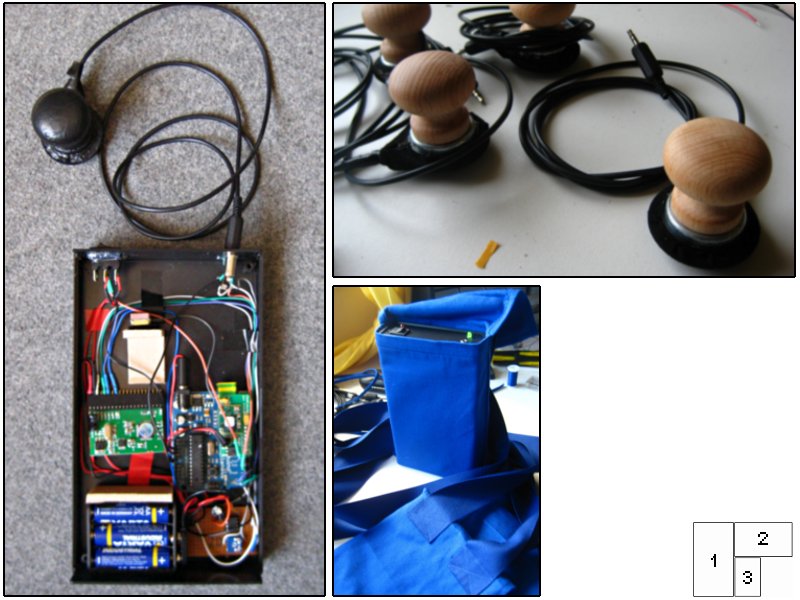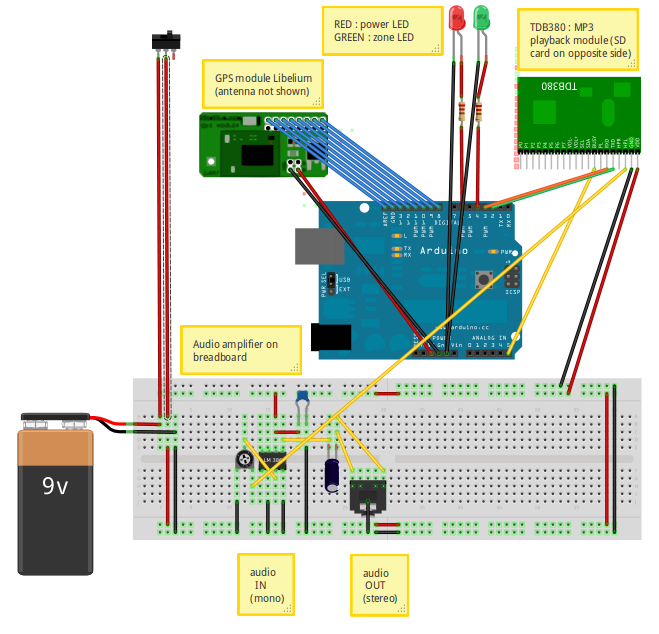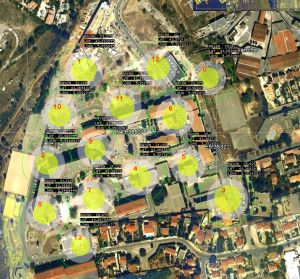« Listening to the walls whisper »

The sound devices described below were used for the first time by Echelle Inconnue in September 2010 in "plan d'Aou", a district of Marseilles, France, within the framework of the Smala project in order to trace a sound cartography of Islam in the city of Marseilles.
About fifteen sound edits were geolocalized in the district, these mobile prototypes gave the possibility to each one to listen to them while walking across "plane d'Aou" (For more information read (in french) : Smala Marseille, or listen online to the sounds edits)
Several cases were imagined for a sound diffusion at the level of the district of "plan d'Aou", and our choice was made on a geolocalized sound system which makes "the walls whisper" by allowing a collective listening, located on places or selected spaces. This solution appeared the most appropriate to the context of the project and the district.
Urban listening
Several mobile systems were distributed to the people to accompany their walk across the district with, by hand, a kind of speaker to be press on the walls which makes it possible to listen to the sound by vibrating the material of the wall.
The materials of urban furniture or buildings become the speakers required for sound diffusion. Each resonant body had its acoustic specificities, the words take shape in metal, wood or glass... Textures of the sound fluctuate from a surface to another and the listener must juggle with these characteristics to obtain a quality of optimal listening, between documentary in the walls and poetic sound creation.
Mobio is also a sound device which reverses usual urban listening : with headphones, personal, intimate. Here we propose a collective listening, the resonance of the talks through materials is audible by a small group of people. This device of auscultation of the city diffuses sounds by giving the illusion to collect them, to listen to the words of the walls, the whisperings through the materials.
Prototypes : arduino + GPS + audio

The prototypes are built around an arduino, using electronic components easily available. According to a modular logic, they can be dismounted, reconfigured and reprogrammed differently for another project. The sound amplifier used to increase the audio signal can be manufactured on a drilled copper plate or made in the form of a printed circuit board fritzing files provided below).
On the same principle we realizedthe software required to place the GPS areas on the district using processing.
Specifications
The mobio device is able to find its geographical position outside with an accuracy of 10 meters, from GPS information and to trigger a sound reading according to this location.
In its manufacture several modular hardware elements come into play :
- a "brain" : an arduino with a microcontroller atmel,
- an associated GPS chip and its module with serial communication,
- a module to read sound files on SD card, also serial interfaced,
- an audio amplifier to boost the signal before it is sent to the vibrating transducer,
- two leds to visualise the operations,
- a vibration speaker, some type of particular loudspeaker of which we kept only the vibrating part reassembled with salvage materials,
- a power supply unit of 9V (6 x 1.5V batteries, standard AA)
The brain of the device built with these elements is programmed with custom software that contains the GPS location information and manages the communication between the various modules. To use it in another place it is necessary to reprogram the microcontroller with specific geographical data, and to change the sounds of the SD card.
Making
Layout

Bill of materials
Material used for the making of the prototypes :
| component / module | supplier | other documents |
| arduino | ||
| GPS Libelium / Tyco | cooking-hacks.com | GPS firmware |
| GPS antenna | cooking-hacks.com | SIRF NMEA Reference Manual |
| Tenda TDB380 : audio playback module mp3 + SD | mdfly.com | alternate choice : AU 5106 |
| DAEX25 sound exciters | parts-express.com | |
| SD card | ||
| IC LM386N-1 (audio amplifier) | ||
| plastic housing red led green led switch case for 6 AA batteries + batteries stereo jack 3.5mm for the audio amplifier : variable resistor 10kOhm electrolytic capacitor 270 µF ceramic capacitor 0,1 µF arduino power jack |
||
Circuits
Various files to be used with fritzing pfor the making of the circuit (see below for the microcontroller code)
Fritzing files :
mobio / fritzing, project file (.fz)
mobio / fritzing, project file in shareable format (.fzz)
New components for Fritzing
TDB380, mp3 playback module, component in shareable format (.fzpz)
LM386, power audio amplifier (.fzpz)
other circuits
Audio amplifier in autonomous version to be used in other projects
audio amplifier x20 with LM386 in shareable format (.fzz)
audio amplifier x20 with LM386 mini version (without jacks) in shareable format (.fzz)
audio amplifier x20 with LM386 mini version (without jacks), circuit board to print (.pdf)
Code
Arduino code necessary to run the device, as well as additional applications are available on gitorious, under GNU-GPL v2 licence which allows its re-use on condition that the re-use is diffused under this licence. .
code : gitorious.org/mobio
Additional applications
Two applications which were useful to us to set up the sound scenario in the district (they are not necessary to operate mobio). The processing code of these following applications is available in the git repository gitorious.org/mobio-prototype-tools
 dérive GPS
dérive GPS
Visualization of the drift produced by the limited accuracy of the GPS to answer the question: how to size an area where the recording of the location is safe?
 localition of areas
localition of areas
Placement of the sound areas on a map. He will need to be tweaked to your map, and cannot be used such as it is. We nevertheless make it available at any useful purpose. To place the zones, any other application can be used, each zone being defined by its geographical coordinates (latitude and longitude) in decimal degrees and its radius in meters.